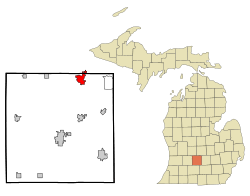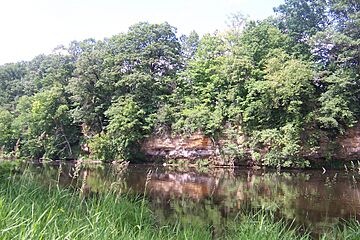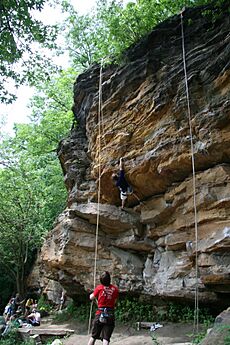Grand Ledge, Michigan facts for kids
Quick facts for kids
Grand Ledge, Michigan
|
|
|---|---|

Location of Grand Ledge in Eaton County, Michigan
|
|
| Country | United States |
| State | Michigan |
| Counties | Eaton, Clinton |
| Area | |
| • Total | 3.94 sq mi (10.19 km2) |
| • Land | 3.84 sq mi (9.94 km2) |
| • Water | 0.10 sq mi (0.25 km2) |
| Elevation | 833 ft (254 m) |
| Population
(2020)
|
|
| • Total | 7,784 |
| • Density | 2,028.67/sq mi (783.27/km2) |
| Time zone | UTC-5 (Eastern (EST)) |
| • Summer (DST) | UTC-4 (EDT) |
| ZIP code |
48837
|
| Area code(s) | 517 |
| FIPS code | 26-33420 |
| GNIS feature ID | 1626372 |

Grand Ledge is a city in the state of Michigan, United States. It is mostly in Eaton County, with a small part in Clinton County. The city is located along the Grand River, about 12.7 miles (20.4 kilometers) west of Lansing.
The city gets its name from its unique sandstone rock ledges. These ledges rise about 40 feet (12 meters) above the Grand River. They are a popular spot for rock climbers. In 2020, about 7,784 people lived in Grand Ledge.
Contents
Discovering Grand Ledge's Past
Early Native American Life
Long ago, Native American tribes lived near the Grand River and its ledges. These tribes included the Pottawatomi, Chippewa, and Ottawa. They used the river for fishing and gathering clams. They also hunted animals like deer, turkey, fox, and bear. The Native Americans called the ledges "Big Rocks."
Modern Settlement Begins
The first European to explore this area by water was Hugh Heward. His journal described the tall sandstone ledges and thick forests. He also noted several small islands in the river.
In 1847, Henry Trench was the first modern settler in the area. By 1850, the village was named Grand Ledge, and a post office was built. A railroad stop arrived in 1869, connecting the town to other places. Grand Ledge officially became a village in Michigan in 1871.
Grand Ledge as a Resort Town
Grand Ledge became a popular resort area in the 1870s. This growth was helped by the new railroad access. John Burtch opened the Seven Islands Resort in 1872. He offered boat rides and a small inn. People believed the mineral water from local wells had healing powers.
In 1877, S.M. Hewings bought the resort and built the Island House Hotel. Julian Scott Mudge took over the resort in 1880. He built a dam in 1887 to control the river's water level. In 1888, a new railroad bridge was built, and Grand Ledge got electric lights. At its peak, 60,000 to 70,000 people visited the resort each year.
The Golden Age of the Resort
In 1891, Mudge added a roller coaster on the islands. This was likely the first one in Michigan. One island had an animal park with bears and deer. The second island was the main hub, with the hotel, picnic areas, and a fountain. A causeway connected the second and third islands. A pavilion there hosted dances and Vaudeville shows. The resort also had a merry-go-round and a bandstand.
Mudge's most famous project was "The Round House." This three-story tower was built partly over the river. Its top two floors were designed to rotate, with a swing that would spin riders over the water. This unique building became a symbol of the resort.
The other islands were used for picnics or left wild. Many boats traveled the Grand River, including large sidewheel riverboats. The dam built in 1887 helped keep the water level right for these boats. Grand Ledge was a very popular destination, second only to the Petoskey resort areas.
The Great Flood of 1893
In 1893, a big flood damaged the Round House. Ice chunks in the rushing water hit its foundation. The building was pushed off its base and tilted. Even though the building was saved, the rotating parts were too damaged to fix. The Round House stayed there, becoming known as "Mudge's Folly." This name meant it was a costly project, but also a beautiful, unique structure.
Grand Ledge's Location
Grand Ledge covers about 3.65 square miles (9.45 square kilometers). Most of this area is land, with a small part being water.
Getting Around Grand Ledge
Roads and Highways
 M-43 connects Grand Ledge to Lansing.
M-43 connects Grand Ledge to Lansing.- M-100 runs north and south, linking Grand Ledge to major highways like Interstate 69 and Interstate 96.
Airport Access
Abrams Municipal Airport (airport codes|||4D0) is a public airport owned by the city. It is located just north of Grand Ledge. The airport is easy to reach by road.
Railroad Connections
The CSX Transportation railroad runs through Grand Ledge. It follows the path of the original railroad built long ago. A small rail yard is still active for local businesses. A large railroad bridge crosses the Grand River near the ledges. This bridge is one of the biggest in Michigan and is a popular sight.
Grand Ledge's Population
| Historical population | |||
|---|---|---|---|
| Census | Pop. | %± | |
| 1880 | 1,387 | — | |
| 1890 | 1,606 | 15.8% | |
| 1900 | 2,161 | 34.6% | |
| 1910 | 2,893 | 33.9% | |
| 1920 | 3,043 | 5.2% | |
| 1930 | 3,572 | 17.4% | |
| 1940 | 3,899 | 9.2% | |
| 1950 | 4,506 | 15.6% | |
| 1960 | 5,165 | 14.6% | |
| 1970 | 6,032 | 16.8% | |
| 1980 | 6,920 | 14.7% | |
| 1990 | 7,579 | 9.5% | |
| 2000 | 7,813 | 3.1% | |
| 2010 | 7,786 | −0.3% | |
| 2020 | 7,784 | 0.0% | |
| U.S. Decennial Census | |||
In 2020, Grand Ledge had 7,784 residents. The city is home to many different people. The average age in 2010 was about 38.8 years old.
Learning in Grand Ledge
The Grand Ledge school district started in 1886. It covers about 125 square miles (324 square kilometers). This area includes the City of Grand Ledge and nearby communities. The district has two early childhood centers, four elementary schools, one middle school, and one high school. The mascot for Grand Ledge High School is the Comet. The school colors are blue and gold.
Rock Climbing Adventures
Oak Park in Grand Ledge is one of the best places for climbing in Michigan. The sandstone cliffs along the river offer nearly 100 climbing routes. These routes range from easy (like 5.2) to very challenging (like 5.13). It's a popular spot for climbers from all over.
Famous People from Grand Ledge
Many notable people have connections to Grand Ledge, including:
- Paul Baribeau, a musician
- Reid Boucher, an NHL hockey player
- Deborah Diesen, a children’s book author
- Frank Fitzgerald, a former Governor of Michigan
- Frank M. Fitzgerald, a lawyer and lawmaker
- John Warner Fitzgerald, a judge
- John Wesley Fitzgerald, a businessman and lawmaker
- Matt Greene, an NHL hockey player
- Al Horford, an NBA basketball player
See also
 In Spanish: Grand Ledge para niños
In Spanish: Grand Ledge para niños


